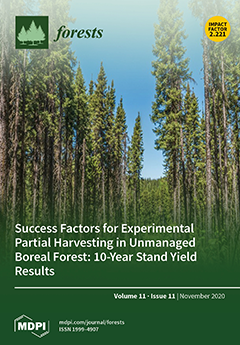Lymantria dispar L. (Lepidoptera: Erebidae) is an international quarantine pest with many hosts, widely distributed in Asia, Europe, and America.
L. dispar is distributed mainly in the Eastern Monsoon Region of China. Currently, the most effective means of prevention and control of this
[...] Read more.
Lymantria dispar L. (Lepidoptera: Erebidae) is an international quarantine pest with many hosts, widely distributed in Asia, Europe, and America.
L. dispar is distributed mainly in the Eastern Monsoon Region of China. Currently, the most effective means of prevention and control of this pest are timely monitoring and early warning. However, their implementation is usually hampered by the lack of feasible methods and tools for fast tracking and traceability. Stable isotope technology can be used for material traceability, but in China, it is rarely employed for insect traceability. Therefore, using
L. dispar as an example, we conducted a case study to explore the feasibility of using hydrogen stable isotopes for pest-source traceability. The grid data of hydrogen stable isotopes of global precipitation were downloaded from the Online Isotopes in Precipitation Calculator (OIPC; Bowen and Revenaugh, 2003, Bowen, 2017), and then, a zoning map of hydrogen stable isotopes of precipitation in mainland China was constructed using ArcGIS 10.4.1 (Esri, Redlands, CA, USA). The wings of 284
L. dispar adults captured in five regions in China were selected as experimental samples. A Finnigan Delta V Advantage Isotope Ratio Mass Spectrometer (Thermo Fisher Scientific, Inc., Waltham, Massachusetts, U.S.) and a Flash 2000 HT Elemental Analyzer (Thermo Fisher Scientific, Inc., Waltham, Massachusetts, U.S.) were used to measure the hydrogen stable isotope (δ
2H) value of the samples. Then, using the recorded local precipitation hydrogen stable isotope of the sampling site, we performed a data simulation using R software (v.3.2.1; R Development Core Team, Vienna, Austria). A linear regression equation was next established: y = 1.186x − 13.247, where x represents the hydrogen stable isotope ratio of precipitation and y denotes the hydrogen stable isotope ratio of
L. dispar. The
t-test,
F-test, and
R2 test results confirmed the high significance and matching with the simulation data used in the model. To further verify the accuracy of the model,
L. dispar samples from Chengdu in Sichuan Province were collected for model back-testing. The verification results also evidenced that the actual source of the
L. dispar sample can be obtained based on the method applied and the model developed in this paper.
Full article





